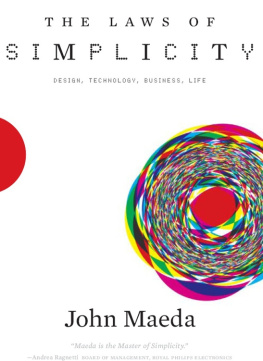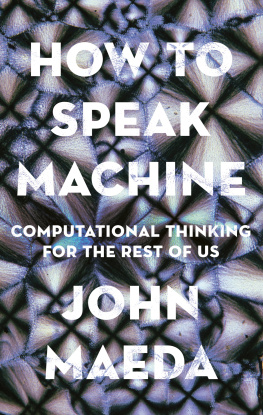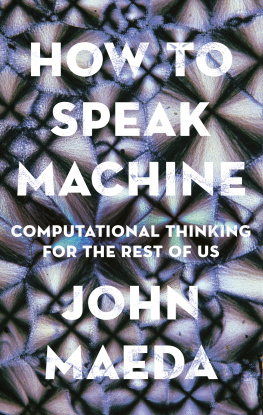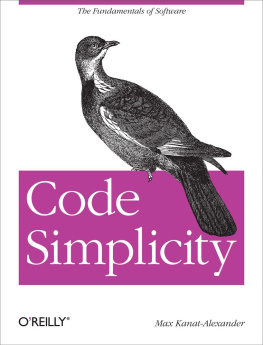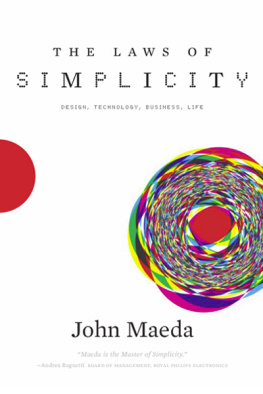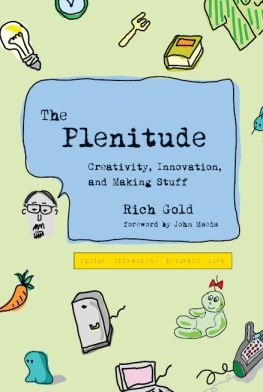John Maeda - The Laws of Simplicity: Design, Technology, Business, Life
Here you can read online John Maeda - The Laws of Simplicity: Design, Technology, Business, Life full text of the book (entire story) in english for free. Download pdf and epub, get meaning, cover and reviews about this ebook. year: 2006, publisher: The MIT Press, genre: Romance novel. Description of the work, (preface) as well as reviews are available. Best literature library LitArk.com created for fans of good reading and offers a wide selection of genres:
Romance novel
Science fiction
Adventure
Detective
Science
History
Home and family
Prose
Art
Politics
Computer
Non-fiction
Religion
Business
Children
Humor
Choose a favorite category and find really read worthwhile books. Enjoy immersion in the world of imagination, feel the emotions of the characters or learn something new for yourself, make an fascinating discovery.
- Book:The Laws of Simplicity: Design, Technology, Business, Life
- Author:
- Publisher:The MIT Press
- Genre:
- Year:2006
- Rating:5 / 5
- Favourites:Add to favourites
- Your mark:
- 100
- 1
- 2
- 3
- 4
- 5
The Laws of Simplicity: Design, Technology, Business, Life: summary, description and annotation
We offer to read an annotation, description, summary or preface (depends on what the author of the book "The Laws of Simplicity: Design, Technology, Business, Life" wrote himself). If you haven't found the necessary information about the book — write in the comments, we will try to find it.
John Maeda: author's other books
Who wrote The Laws of Simplicity: Design, Technology, Business, Life? Find out the surname, the name of the author of the book and a list of all author's works by series.
The Laws of Simplicity: Design, Technology, Business, Life — read online for free the complete book (whole text) full work
Below is the text of the book, divided by pages. System saving the place of the last page read, allows you to conveniently read the book "The Laws of Simplicity: Design, Technology, Business, Life" online for free, without having to search again every time where you left off. Put a bookmark, and you can go to the page where you finished reading at any time.
Font size:
Interval:
Bookmark:
DESIGN, TECHNOLOGY, BUSINESS, LIFE
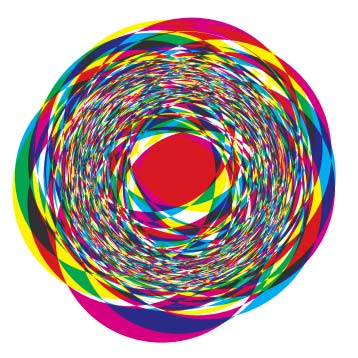
Maeda is the Master of Simplicity.
Andrea Ragnetti board of management, royal philips electronics
simplicity = sanity
I watched the process whereby my daughters gleefully got their first email accounts. It began as a tiny dropemails sent among themselves. It grew to a slow drip as their friends joined the flow of communication. Today it is a waterfall of messages, e-cards, and hyperlinks that showers upon them daily.
I urge them to resist the temptation to check their email throughout the day. As adults, I tell them, they will have ample opportunity to swim in the ocean of information. Stay away! I warn, because even as an Olympic-class technologist, I find myself barely keeping afloat. I know that Im not alone in this feeling of constantly drowningmany of us regularly engage (or dont) in hundreds of email conversations a day. But I feel somewhat responsible.
My early computer art experiments led to the dynamic graphics common on websites today. You know what Im talk ing aboutall that stu flying around on the computer screen while youre trying to concentratethats me. I am partially to blame for the unrelenting stream of eye candy littering the information landscape. I am sorry, and for a long while I have wished to do something about it.
Achieving simplicity in the digital age became a personal mission, and a focus of my research at MIT. There, I straddle the fields of design, technology, and business as both educator and practitioner. Early in my ruminations I had the simple observation that the letters M, I, and Tthe letters by which my university is knownoccur in natural sequence in the word si m pl i ci t y. In fact, the same can be said of the word co m plex it y. Given that the T in M-I-T stands for technologywhich is the very source of much of our feeling overwhelmed todayI felt doubly responsible that someone at MIT should take a lead in correcting the situation.
In 2004, I started the MIT SIMPLICITY Consortium at the Media Lab, comprised of roughly ten corporate partners that include AARP, Lego, Toshiba, and Time. Our mission is to define the business value of simplicity in communication, healthcare, and play. Together we design and create prototype systems and technologies that point to directions where simplicity-driven products can lead to market success. By the publication date of this book, a novel networked digital photo playback product co-developed with Samsung will serve as an important commercial data point to test the validity of the Consortiums stance on simplicity.
When the blogosphere began to emerge, I responded and created a blog about my evolving thoughts on simplicity. I set out to find a set of laws of simplicity and targeted sixteen principles as my goal. Like most blogs, it has been a place where I have shared unedited thoughts that represent my personal opinions on a topic about which I am passionate. And although the theme of the blog began just along the lines of design, technology, and business I discovered that the readership resonated with the topic that underlies it all: my struggle to understand the meaning of life as a humanist technologist.
Through my ongoing journey Ive discovered how complex a topic simplicity really is, and I dont pretend to have solved the puzzle. Having recently spoken to an 85-year old MIT linguistics professor who has been working on the same problem his entire life, I am inspired to grapple with this puzzle for many more years. My blog led me to the fact that there arent sixteen laws, but rather the ten published in this volume. Like all man-made laws they do not exist in the absolute senseto break them is no sin. However you may find them useful in your own search for simplicity (and sanity) in design, technology, business, and life.
SIMPLICITY AND THE MARKETPLACE
The marketplace abounds with promises of simplicity. Citibank has a simplicity credit card, Ford has keep it simple pricing, and Lexmark vows to uncomplicate the consumer experience. Widespread calls for simplicity formed a trend that was inevitable, given the structure of the technology business around selling the same thing new and improved where often improved simply means more. Imagine a world in which software companies simplified their programs every year by shipping with 10% fewer features at 10% higher cost due to the expense of simplification. For the consumer to get less and pay more seems to contradict sound economic principles. Oer to share a cookie with a child and which half will the child want?
Yet in spite of the logic of demand, simplicity sells as espoused by New York Times columnist David Pogue in a presentation at the 2006 annual TED Conference in Monterey. The undeniable commercial success of the Apple iPoda device that does less but costs more than other digital music players is a key supporting example of this trend. Another example is the deceivingly spare interface of the powerful Google search engine, which is so popular that googling has become shorthand for searching the Web. People not only buy, but more importantly love, designs that can make their lives simpler. For the foreseeable future, complicated technologies will continue to invade our homes and workplaces, thus simplicity is bound to be a growth industry.
Simplicity is a quality that not only evokes passionate loyalty for a product design, but also has become a key strategic tool for businesses to confront their own intrinsic complexities. Dutch conglomerate Philips leads in this area with its utter devotion to realizing sense and simplicity. In 2002 I was invited by Board of Management Member Andrea Ragnetti to join Philips Simplicity Advisory Board (SAB). I initially thought that sense and simplicity was merely a branding eort, but when I met in Amsterdam with Ragnetti and his CEO Gerard Kleisterlee at the first meeting of the SAB I saw the greater ambition. Philips plan to reorganize not only all of their product lines, but also their entire set of business practices around simplicity. When I tell this story to industry leaders the consistent feedback I get is that Philips is not alone in the quest to reduce the complexities of doing business. The hunt is on for simpler, more ecient ways to move the economy forward.
1 reduce The simplest way to achieve simplicity is through thoughtful reduction.
2 organize Organization makes a system of many appear fewer.
3 time Savings in time feel like simplicity.
4 learn Knowledge makes everything simpler.
5 dierences Simplicity and complexity need each other.
6 context What lies in the periphery of simplicity is definitely not peripheral.
7 emotion More emotions are better than less.
8 trust In simplicity we trust.
9 failure Some things can never be made simple. 10 the one Simplicity is about subtracting the obvious, and adding the meaningful.
1 away More appears like less by simply moving it far, far away.
2 open Openness simplifies complexity.
3 power Use less, gain more.
WHOM IS THIS BOOK FOR?
As an artist, Id like to say that I wrote this book for myself in the spirit of climbing a mountain because its there. But the reality is that I wrote it in response to the many voices of encouragementeither by email or in personfrom people that wish to better understand simplicity. Ive heard from biochemists, production engineers, digital artists, homemakers, technology entrepreneurs, road construction administrators, fiction writers, realtors, and oce workers, and the interest just seems to keep on growing. With support there is always discouragement: some worry about the negative connotations of simplicity where it can lead to a simplistic and dumbed-down world. You will see in the latter part of this book that I position complexity and simplicity as having importance relative to each other as necessary rivals. Thus I realize that although the idea of ridding the earth of complexity might seem the shortest path to universal simplicity, it may not be what we truly desire.
Font size:
Interval:
Bookmark:
Similar books «The Laws of Simplicity: Design, Technology, Business, Life»
Look at similar books to The Laws of Simplicity: Design, Technology, Business, Life. We have selected literature similar in name and meaning in the hope of providing readers with more options to find new, interesting, not yet read works.
Discussion, reviews of the book The Laws of Simplicity: Design, Technology, Business, Life and just readers' own opinions. Leave your comments, write what you think about the work, its meaning or the main characters. Specify what exactly you liked and what you didn't like, and why you think so.

